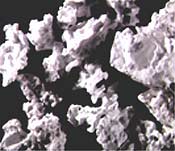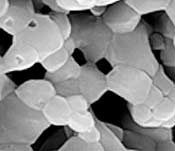Osteoinductive bone filler enters European market
IsoTis officials cite it is the first osteoinductive synthetic bone substitute to receive the CE mark.
 BILTHOVEN, Netherlands — Officials with the Swiss/Dutch biosurgery firm IsoTis SA announced the CE mark approval
and commercial launch of OsSatura, a synthetic bone substitute that its
developers say is both osteoconductive and osteoinductive.
BILTHOVEN, Netherlands — Officials with the Swiss/Dutch biosurgery firm IsoTis SA announced the CE mark approval
and commercial launch of OsSatura, a synthetic bone substitute that its
developers say is both osteoconductive and osteoinductive.
The new bone substitute will first be used in dental applications, but it is targeted for the multimillion-dollar worldwide market now occupied by other orthopaedic bone void fillers, allograft bone and demineralized bone matrix (DBM).
IsoTis officials signed a distribution agreement for OsSatura with dental technology firm BEGO Semados in March. The agreement grants the German company exclusive distribution rights of OsSatura Dental, OsSatura’s dental counterpart, in Europe, the rest of the world and possibly the United States. “With this agreement, we are taking a big step toward meeting our sales targets,” said Jacques R. Essinger, PhD, chief executive officer of IsoTis SA.
In February, OsSatura became the first synthetic bone substitute given the CE mark based on an osteoinductivity claim. That month, the company also officially launched the product at the 70th Annual Meeting of the American Academy of Orthopaedic Surgeons.
Replaces DBM
OsSatura is a synthetic bone substitute composed of 80/20 hydroxyapatite and ß-tricalcium phosphate (ß-TCP). It is nearly 75% porous, with interconnected macro- and micropores.
 --- IsoTis’ OsSatura is a
synthetic bone void filler made of hydroxyapatite and ß-tricalcium
phosphate that is osteoinductive and osteoconductive. It was discovered nearly
by accident by researchers.
--- IsoTis’ OsSatura is a
synthetic bone void filler made of hydroxyapatite and ß-tricalcium
phosphate that is osteoinductive and osteoconductive. It was discovered nearly
by accident by researchers.
COURTESY OF ISOTIS
In the dental and orthopaedic markets, the product is well positioned to challenge standard DBM products, many of which are produced from bovine bone, Essinger said. Those DBMs have been scrutinized more closely in recent months due to increased concern over their potential for disease transfer.
“[OsSatura] is synthetic; it’s not of animal origin. This may be an alternative to bone morphogenetic proteins (BMPs) because it’s more competitive in price,” he told Orthopaedics Today.
How is OsSatura osteoinductive? Developers aren’t exactly sure, Essinger said, but the attraction of endogenous BMPs starts the process. Micropores are also involved. “We know from documented research that the microporous structure is related to the spontaneous osteoinductive effect that we see,” he said.
Attracting BMPs
When placed in the body, endogenous BMPs from blood and fluids eventually attach to OsSatura’s surface due to the acidity of the hydroxyapatite. “The assumption is that the microporous structure allows enough BMPs to be attracted inside the OsSatura to reach the saturation level where the stem cells start to begin to differentiate,” Essinger said.
 --- The microporous structure of
OsSatura may cause bone growth to occur, according to developers.
--- The microporous structure of
OsSatura may cause bone growth to occur, according to developers.
COURTESY OF ISOTIS
For the CE mark, investigators conducted large animal studies showing that the full spectrum of bone — from osteoid to mature bone — was formed after OsSatura was placed in muscle and other areas where bone does not normally grow. Researchers also conducted critical size defect studies on OsSatura, as well in as animal studies using the product for spine fusion and dental reconstruction.
In January, IsoTis applied to the U.S. Food and Drug Administration for 510(k) approval of OsSatura, foregoing the osteoinductive claim in favor of an accelerated approval. “We want to get our product as quickly as possible into the United States,” Essinger said.
Protocols for clinical trials in Europe are being finalized, as are plans for possibly distributing the product in Asia and other parts of the world.
Dr. Essinger has a financial interest in the product mentioned in this article.
